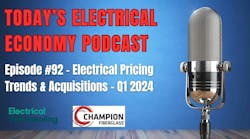ABI slips 2.7 points in October. Following three months of accelerating demand for design services, the Architecture Billings Index (ABI) indicated a somewhat slower pace of growth in October. As a leading economic indicator of construction activity, the ABI reflects the nine- to twelve-month lead time between architecture billings and construction spending. The American Institute of Architects (AIA) reported the October ABI score was 51.6, down from a mark of 54.3 in September. This score shows an increase in design services (any score above 50 indicates an increase in billings). The new projects inquiry index was 61.5, up from 58.6 the previous month.
“There continues to be a lot of uncertainty surrounding the overall U.S. economic outlook and therefore in the demand for nonresidential facilities, which often translates into slower progress on new building projects,” said AIA Chief Economist Kermit Baker.
Purchasing Managers Index still rising in October. Activity in the manufacturing sector expanded in October for the fifth consecutive month, and the overall economy grew for the 53rd consecutive month, say the nation’s supply executives in the Tempe, Ariz.-based Institute for Supply Management’s latest Manufacturing Report On Business. The PMI registered 56.4%, an increase of 0.2% from September’s reading of 56.2%. The PMI has increased progressively each month since June, with October’s reading the highest PMI in 2013. The New Orders Index increased slightly in October by 0.1% to 60.6%, while the Production Index decreased by 1.8% to 60.8%. Both the New Orders and Production Indexes have been above 60% for three consecutive months.
U.S. Leading Economic Index still looks solid. The Conference Board Leading Economic Index (LEI) for the U.S. increased 0.7% in September to 97.1 (2004 = 100), following a 0.7% increase in August, and a 0.4% increase in July. “The September LEI suggests the economy was expanding modestly and possibly gaining momentum before the government shutdown,” said Ken Goldstein, an economist at The Conference Board. “Beyond the immediate fallout of the shutdown, the biggest challenge is whether relatively weak consumer demand, pinned down by weak wage growth and low levels of confidence, will recover during the final stretch of 2013 and into 2014.”








